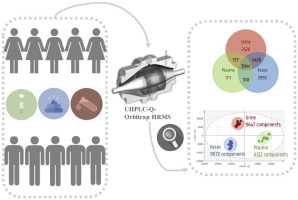当前位置:
X-MOL 学术
›
Anal. Chim. Acta
›
论文详情
Our official English website, www.x-mol.net, welcomes your feedback! (Note: you will need to create a separate account there.)
A validated multi-matrix platform for metabolomic fingerprinting of human urine, feces and plasma using ultra-high performance liquid-chromatography coupled to hybrid orbitrap high-resolution mass spectrometry
Analytica Chimica Acta ( IF 6.2 ) Pub Date : 2018-11-01 , DOI: 10.1016/j.aca.2018.06.065 Ellen De Paepe , Lieven Van Meulebroek , Caroline Rombouts , Steve Huysman , Kaat Verplanken , Bruno Lapauw , Jella Wauters , Lieselot Y. Hemeryck , Lynn Vanhaecke
Analytica Chimica Acta ( IF 6.2 ) Pub Date : 2018-11-01 , DOI: 10.1016/j.aca.2018.06.065 Ellen De Paepe , Lieven Van Meulebroek , Caroline Rombouts , Steve Huysman , Kaat Verplanken , Bruno Lapauw , Jella Wauters , Lieselot Y. Hemeryck , Lynn Vanhaecke

|
In recent years, metabolomics has surfaced as an innovative research strategy in human metabolism, whereby selection of the biological matrix and its inherent metabolome is of crucial importance. However, focusing on a single matrix may imply that relevant molecules of complementary physiological pathways, covered by other matrices, are missed. To address this problem, this study presents a unique multi-matrix platform for polar metabolic fingerprinting of feces, plasma and urine, applying ultra-high performance liquid-chromatography coupled to hybrid quadrupole-Orbitrap high-resolution mass spectrometry, that is able to achieve a significantly higher coverage of the system's metabolome and reveal more significant results and interesting correlations in comparison with single-matrix analyses. All three fingerprinting approaches were proven 'fit-for-purpose' through extensive validation in which a number of endogenous metabolites were measured in representative quality control samples. For targeted and untargeted validation of all three matrices, excellent linearity (coefficients of determination R2 ≥ 0.99 or 0.90 respectively), recovery and precision (coefficients of variance ≤ 15% or 30% respectively) were observed. The potential of the platform was demonstrated by subjecting fecal, urine and plasma samples (collected within one day) from ten healthy volunteers to metabolic fingerprinting, yielding respectively 9 672, 9 647, and 6122 components. Orthogonal partial least-squares discriminant analysis provided similar results for feces and plasma to discriminate according to gender (p-value, R2(X), R2(Y) and Q2(Y)), suggesting feces as an excellent alternative biofluid to plasma. Moreover, combining the different matrices improved the model's predictivity, indicating the superiority of multi-matrix platforms for research purposes in biomarker detection or pathway elucidation and in the selection of the most optimal matrix for future clinical purposes.
中文翻译:

一个经过验证的多矩阵平台,使用超高性能液相色谱与混合轨道阱高分辨率质谱联用,对人体尿液、粪便和血浆进行代谢组学指纹识别
近年来,代谢组学作为人体代谢的一种创新研究策略浮出水面,其中生物基质及其固有代谢组的选择至关重要。然而,专注于单一基质可能意味着被其他基质覆盖的互补生理途径的相关分子被遗漏了。为了解决这个问题,本研究提出了一种独特的多基质平台,用于粪便、血浆和尿液的极性代谢指纹识别,将超高性能液相色谱与混合四极杆-Orbitrap 高分辨率质谱联用,能够实现与单矩阵分析相比,系统代谢组的覆盖率明显更高,并揭示了更重要的结果和有趣的相关性。通过广泛的验证,所有三种指纹识别方法都被证明“适合目的”,其中在代表性质量控制样本中测量了许多内源性代谢物。对于所有三个基质的靶向和非靶向验证,观察到出色的线性(测定系数 R2 分别≥ 0.99 或 0.90)、回收率和精密度(变异系数分别≤ 15% 或 30%)。该平台的潜力通过对 10 名健康志愿者的粪便、尿液和血浆样本(在一天内收集)进行代谢指纹识别,分别产生 9 672、9 647 和 6122 种成分来证明。正交偏最小二乘判别分析为粪便和血浆提供了类似的结果,可根据性别(p 值、R2(X)、R2(Y) 和 Q2(Y))进行区分,建议粪便作为血浆的一种极好的替代生物流体。此外,组合不同的矩阵提高了模型的预测能力,表明多矩阵平台在生物标志物检测或通路阐明的研究目的以及为未来临床目的选择最佳矩阵方面的优越性。
更新日期:2018-11-01
中文翻译:

一个经过验证的多矩阵平台,使用超高性能液相色谱与混合轨道阱高分辨率质谱联用,对人体尿液、粪便和血浆进行代谢组学指纹识别
近年来,代谢组学作为人体代谢的一种创新研究策略浮出水面,其中生物基质及其固有代谢组的选择至关重要。然而,专注于单一基质可能意味着被其他基质覆盖的互补生理途径的相关分子被遗漏了。为了解决这个问题,本研究提出了一种独特的多基质平台,用于粪便、血浆和尿液的极性代谢指纹识别,将超高性能液相色谱与混合四极杆-Orbitrap 高分辨率质谱联用,能够实现与单矩阵分析相比,系统代谢组的覆盖率明显更高,并揭示了更重要的结果和有趣的相关性。通过广泛的验证,所有三种指纹识别方法都被证明“适合目的”,其中在代表性质量控制样本中测量了许多内源性代谢物。对于所有三个基质的靶向和非靶向验证,观察到出色的线性(测定系数 R2 分别≥ 0.99 或 0.90)、回收率和精密度(变异系数分别≤ 15% 或 30%)。该平台的潜力通过对 10 名健康志愿者的粪便、尿液和血浆样本(在一天内收集)进行代谢指纹识别,分别产生 9 672、9 647 和 6122 种成分来证明。正交偏最小二乘判别分析为粪便和血浆提供了类似的结果,可根据性别(p 值、R2(X)、R2(Y) 和 Q2(Y))进行区分,建议粪便作为血浆的一种极好的替代生物流体。此外,组合不同的矩阵提高了模型的预测能力,表明多矩阵平台在生物标志物检测或通路阐明的研究目的以及为未来临床目的选择最佳矩阵方面的优越性。



























 京公网安备 11010802027423号
京公网安备 11010802027423号